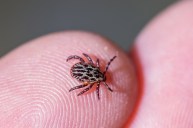What's one of the worst tick stories I've heard? A couple in Colorado rushed their dog to the vet as he was paralyzed after a camping trip in Boulder County. The vets said ticks were to blame. Canine tick paralysis is a rare but potentially fatal condition that renders dogs unable to move from the neck down. I would be terrified if my dog was paralyzed and I had no idea why! Dogs can get ticks when walking in the woods or through high grasses. They lie and wait. Ticks are common in certain areas of the country including where I live in the southern corner of Washington.
Ticks transmit many parasitic, bacterial, viral and other diseases, such as Lyme disease, among animals and from animals to humans. The salivary secretions of some female ticks are toxic and what produce "tick paralysis" in people and animals. Per Mosquito Squad, these are the Top 10 Tick States during their recent campaign with Thermacell.
Top 10 Tick States
10. Minnesota
9. Virginia
8. Maryland
7. Maine
6. Connecticut
5. New Jersey
4. New Hampshire
3. Pennsylvania
2. Massachusetts
1. New York
So if you here are a number of symptoms pet parents should be aware of, we hope you find these helpful!
-
Arthritis or lameness that lasts for three to four days
-
Reluctance to move
-
Swollen joints
-
fever, fatigue
-
Swollen lymph nodes
-
Loss of appetite and neurological problems
There are products available that repel or prevent ticks from attaching, and products that kill ticks within hours after they have attached. Of course, regional risks and a pet's lifestyle should be considered. Talk to your vet about the products they recommend as these range from oral tablets to tick collars depending on your lifestyle and where you live.
How do you safely remove ticks if you find them? PetMD.com tells us to look in these five places when scouring for ticks.
Common Hiding Spots for Ticks on Dogs
1. In and around the ears
Always check around floppy ears!
2. Underclothes and collars
Remove that collar when you return home and look for ticks!
3. The eyelids
Is it a skin tag or a tick? Double check anything that looks odd.
4. Between the toes (I've found them here on my dogs!)
A tick can attach between the toes. Be careful when you remove them!
5. The groin area
Ticks are drawn to moist areas of the body. Check the groin just in case.
Are you surprised by these areas? Always make sure to look here after you've gone hiking!
Tick removal can be tricky so after watching the video, ask your vet or vet tech for any tips as the tick needs to be removed directly from the dog's skin with a pair of tweezers. There are many effective tick products that work well! Always look at your dog's fur or pet's skin even if you are using a tick preventative.
Ticks are a serious matter so if you live in or near a wooded area (year-round or on vacation) you should use tick prevention or tick control.
In addition to Lyme disease and Rocky Mountain spotted fever, tick exposure may transmit diseases including anaplasmosis, babesiosis, ehrlichiosis, and mycoplasmosis.
There are many species of ticks depending where you live including the American dog tick or wood tick which is found in the eastern two-thirds of the United States.
Have you seen a tick on your dog? Please leave a comment below.
This article was originally published April 5, 2019.
WATCH NOW: 8 Things to Bring When Camping with Your Dog




